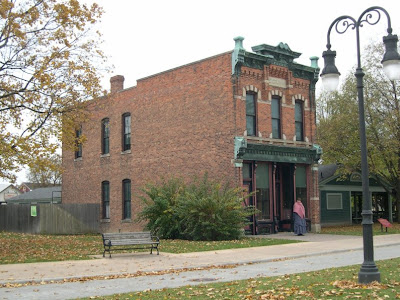The Waterford Country Store aka Elias A. Brown's General Store aka J.R. Jones General Store
 Although this building, built in 1854 in Waterford, Michigan (about 30 miles north of Detroit), was not the first acquisition Henry Ford made for his new outdoor museum - as far as I have read, that distinction goes to the Scotch Settlement School - the Waterford Country Store was the first structure to arrive at the village site.
Although this building, built in 1854 in Waterford, Michigan (about 30 miles north of Detroit), was not the first acquisition Henry Ford made for his new outdoor museum - as far as I have read, that distinction goes to the Scotch Settlement School - the Waterford Country Store was the first structure to arrive at the village site.
Purchased in 1927 with the promise to the owner that a new brick building would replace it, the store was dismantled within a month of its purchase and re-erected in the Village shortly after. However, it was not placed in its permanent location facing the village green until spring of 1929.

Once settled inside of Ford's new Village, this store was called the Waterford Country Store, in honor of its original location. But shortly after, it received the name Elias A. Brown's General Store due to its stock coming from Mr. Brown's store in New York. This stock was passed on to Mr. Ford with the understanding that the name of the old gentleman who had once been proprietor be placed above the door. And, although Brown had no connection with this particular building what-so-ever - aside from providing display stock - that's where the name remained for over 50 years.
Research shows that the Village began a serious transformation of the store from Elias Brown into the J.R. Jones General Store in the early 1990's, with completion by opening day 1994. J.R. Jones was the proprietor during the 1880's while the building stood in its original Waterford location, and the Village decided to portray it from that period.

Another reason for the change was that the curators had found the store was inconsistent in its presentation, from the name Ford had used (Elias Brown was from upstate New York) to the product on display, which ranged from the 1830's through the 1930's. So, in 1990, a project team was appointed and began their tedious historical research to restore, reinstall, and reinterpret the building. They researched all resources about general stores including account books. They also researched local Waterford history including newspaper advertisements of the 1880's. They even asked visitors at the Village what they expected to see inside the store.
Since re-opening in 1994, the J.R. Jones General Store appears much the same as it would have in the mid-1880's. Over 3,000 original objects with 2500 reproductions were installed to simulate an actual working store, implying that folks of the late 19th century had a greater quantity and variety of product to choose from than otherwise was believed, as well as showing how said product fit into people's everyday lives.

With this transformation, the J.R. Jones General Store now shows how most stores of this era housed everything needed for the surrounding community in which it served. From dry goods and tools to certain foods, patent medicines, household utensils, fancy jewelry, material for clothing, shoes, hats, cracker barrels, and maybe even a bit of hard candy and a small selection of toys, the general store was the heart of the community. The store served as a meeting place for friends, who swapped stories and debated politics out front in the warm weather and near the potbellied stove in the cooler months.

The storekeeper knew the latest news and often served as the Justice of the Peace and the Village Postmaster.

During the summer months, Waterford, in the 1880's, drew a large number of vacationers from Detroit and Lansing, as it was a resort community.  And, Greenfield Village now entertains visitors during the summer months by presenting a 15 minute skit about a pain-in-the-butt "city" lady customer and how she irritates the proprietor, Mr. Jones.
And, Greenfield Village now entertains visitors during the summer months by presenting a 15 minute skit about a pain-in-the-butt "city" lady customer and how she irritates the proprietor, Mr. Jones.
 The restoration process of the General Store has been done as accurately as can possibly be done, and one can safely assume the time-travel feeling when entering the structure.
The restoration process of the General Store has been done as accurately as can possibly be done, and one can safely assume the time-travel feeling when entering the structure.
Mr. Ford would be proud.
 And, Greenfield Village now entertains visitors during the summer months by presenting a 15 minute skit about a pain-in-the-butt "city" lady customer and how she irritates the proprietor, Mr. Jones.
And, Greenfield Village now entertains visitors during the summer months by presenting a 15 minute skit about a pain-in-the-butt "city" lady customer and how she irritates the proprietor, Mr. Jones. The restoration process of the General Store has been done as accurately as can possibly be done, and one can safely assume the time-travel feeling when entering the structure.
The restoration process of the General Store has been done as accurately as can possibly be done, and one can safely assume the time-travel feeling when entering the structure.Mr. Ford would be proud.
.




Comments